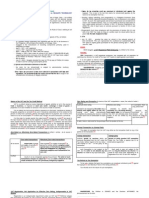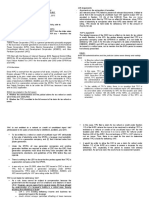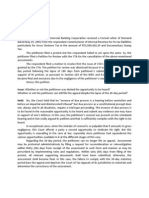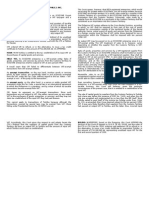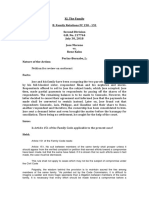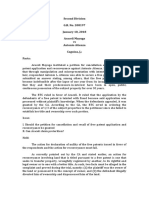Kepco Vs Cir Case Digest
Kepco Vs Cir Case Digest
Uploaded by
jovifactorCopyright:
Available Formats
Kepco Vs Cir Case Digest
Kepco Vs Cir Case Digest
Uploaded by
jovifactorOriginal Description:
Original Title
Copyright
Available Formats
Share this document
Did you find this document useful?
Is this content inappropriate?
Copyright:
Available Formats
Kepco Vs Cir Case Digest
Kepco Vs Cir Case Digest
Uploaded by
jovifactorCopyright:
Available Formats
KEPCO PHILIPPINES CORPORATION VS.
CIR
FACTS:
Petitioner KEPCO Philippines is a VAT-registered independent power producer engaged in
the business of generating electricity. Kepco filed an application for zero-rated sales, which
was approved. It filed a claim for tax refund covering the unutilized VAT payments attributable
to its zero-rated sales transactions. The claim was denied. On appeal to the CTA, the court
denied it for failure to comply with the substantiation requirement regarding the invoices or
official receipts Kepco issued.
Kepco lifted the issue to the Supreme Court arguing that under Section 113 (A) of the 1997
NIRC, invoices and official receipts are used interchangeably for purposes of substantiating
input VAT.
ISSUE:
Whether or not the invoices and official receipts can be interchangeably used
HELD:
No. Under the law, a VAT invoice is necessary for every sale, barter or exchange of goods or
properties while a VAT official receipt properly pertains to every lease of goods or properties,
and for every sale, barter or exchange of services.
In other words, the VAT invoice is the sellers best proof of the sale of the goods or services to
the buyer while the VAT receipt is the buyers best evidence of the payment of goods or
services received from the seller. Even though VAT invoices and receipts are normally issued
by the supplier/seller alone, the said invoices and receipts, taken collectively, are necessary
to substantiate the actual amount or quantity of goods sold and their selling price (proof of
transaction), and the best means to prove the input VAT payments (proof of payment).
Hence, VAT invoice and VAT receipt should not be confused as referring to one and the
same thing. Certainly, neither does the law intend the two to be used alternatively.
FACTOR, J.V.
You might also like
- CIR Vs CTA and CitysuperDocument3 pagesCIR Vs CTA and CitysuperEllaine BernardinoNo ratings yet
- Asian Transmission Corporation vs. CIR DigestDocument3 pagesAsian Transmission Corporation vs. CIR DigestEmir Mendoza100% (2)
- Silicon Philippines vs. Cir DigestDocument1 pageSilicon Philippines vs. Cir DigestAnny YanongNo ratings yet
- CIR Vs Sony DigestDocument2 pagesCIR Vs Sony DigestPre Avanz83% (6)
- Taxation 2 Case DigestsDocument148 pagesTaxation 2 Case DigestsMa BelleNo ratings yet
- Atlas Consolidated Mining Development Corp. v. CIRDocument1 pageAtlas Consolidated Mining Development Corp. v. CIRIsh50% (2)
- Peralta Vs Municipality of Kalibo Case DigestDocument2 pagesPeralta Vs Municipality of Kalibo Case Digestjovifactor80% (5)
- Kepco Vs CIRDocument3 pagesKepco Vs CIRLizzette Dela PenaNo ratings yet
- CIR v. Liquigaz Case DigestDocument3 pagesCIR v. Liquigaz Case DigestKian Fajardo100% (3)
- G.R. No. 207112 Case DigestDocument3 pagesG.R. No. 207112 Case DigestAlvin Earl NuydaNo ratings yet
- Part C 1 - CIR Vs Avon Products ManufacturingDocument4 pagesPart C 1 - CIR Vs Avon Products ManufacturingCyruz Tuppal75% (4)
- MEDICARD PHILIPPINES V CIR DIGESTDocument3 pagesMEDICARD PHILIPPINES V CIR DIGESTMiguel100% (3)
- Jaka Investment Vs CIR - CDDocument2 pagesJaka Investment Vs CIR - CDNolas Jay100% (1)
- Lascona Land Vs CIRDocument2 pagesLascona Land Vs CIRJOHN SPARKSNo ratings yet
- CIR Vs Next MobileDocument2 pagesCIR Vs Next Mobilegeorge almeda100% (1)
- Tax Rev Digest Mindanao II Geothermal Partnership V CirDocument4 pagesTax Rev Digest Mindanao II Geothermal Partnership V CirCalypso75% (4)
- Samar-I Electric Cooperative vs. CirDocument2 pagesSamar-I Electric Cooperative vs. CirRaquel DoqueniaNo ratings yet
- Cir v. Domingo Jewellers Inc DigestDocument2 pagesCir v. Domingo Jewellers Inc DigestjohanyarraNo ratings yet
- Spouses Pacquiao vs. CTA and CIRDocument3 pagesSpouses Pacquiao vs. CTA and CIRRhea CagueteNo ratings yet
- CIR Vs Seagate, GR 153866Document3 pagesCIR Vs Seagate, GR 153866Mar Develos100% (1)
- Pagcor Vs BirDocument2 pagesPagcor Vs BirTonifranz SarenoNo ratings yet
- CIR vs. La Flor Isabela 211289Document1 pageCIR vs. La Flor Isabela 211289magen100% (1)
- CIR vs. Systems Technology InstituteDocument2 pagesCIR vs. Systems Technology InstituteMaria100% (3)
- Cir vs. Pascor Realty and Development CorporationDocument2 pagesCir vs. Pascor Realty and Development Corporationmaki Amancio100% (1)
- CIR Vs Toledo DigestDocument2 pagesCIR Vs Toledo DigestClar Napa100% (2)
- CIR Vs Cebu Toyo CorporationDocument2 pagesCIR Vs Cebu Toyo Corporationjancelmido1100% (2)
- Asian Transmission Corp. vs. CIRDocument2 pagesAsian Transmission Corp. vs. CIRRhea Caguete50% (2)
- Commissioner of Internal Revenue v. Spouses Magaan, G.R. No. 232663, (May 3, 2021)Document28 pagesCommissioner of Internal Revenue v. Spouses Magaan, G.R. No. 232663, (May 3, 2021)Kriszan ManiponNo ratings yet
- Cir V Pascor RealtyDocument3 pagesCir V Pascor RealtyCharmaine Mejia100% (2)
- CIR vs. Metro Star Superama Inc.Document1 pageCIR vs. Metro Star Superama Inc.DaLe AparejadoNo ratings yet
- CIR V Fitness by DesignDocument3 pagesCIR V Fitness by Designsmtm06100% (4)
- Philamlife vs. CIRDocument1 pagePhilamlife vs. CIRMona LizaNo ratings yet
- City of Pasig vs. PCGG (G.r. No. 185023)Document3 pagesCity of Pasig vs. PCGG (G.r. No. 185023)Ray John Uy-Maldecer AgregadoNo ratings yet
- 6 CIR vs. Next Mobile, GR No. 212825Document2 pages6 CIR vs. Next Mobile, GR No. 212825Joshua Erik Madria100% (2)
- Samar Electric Cooperative vs. CIRDocument3 pagesSamar Electric Cooperative vs. CIRAnneNo ratings yet
- CIR v. Suyoc MinesDocument1 pageCIR v. Suyoc MinesPatricia SulitNo ratings yet
- Succession - Heirs of Reganon Vs Imperial 22 Scra 80Document3 pagesSuccession - Heirs of Reganon Vs Imperial 22 Scra 80Karla Marie Tumulak100% (2)
- Herarc Realty Corporation vs. The Provincial Treasurer of Batangas DigestDocument2 pagesHerarc Realty Corporation vs. The Provincial Treasurer of Batangas DigestEmir MendozaNo ratings yet
- Silicon Philippines V CirDocument2 pagesSilicon Philippines V CirKia BiNo ratings yet
- Kepco Ilijan Corp v. CIRDocument4 pagesKepco Ilijan Corp v. CIRPatrick ManaloNo ratings yet
- CIR vs. Pascor RealtyDocument3 pagesCIR vs. Pascor RealtyZyrilla Jeoville De LeonNo ratings yet
- Rhombus Energy, Inc. vs. Commissioner of Internal Revenue DigestDocument2 pagesRhombus Energy, Inc. vs. Commissioner of Internal Revenue DigestEmir Mendoza100% (1)
- CIR vs. Magsaysay Lines Inc DigestDocument2 pagesCIR vs. Magsaysay Lines Inc Digestmisscyu100% (1)
- Republic V RicarteDocument1 pageRepublic V RicarteReena MaNo ratings yet
- Cir VS AvonDocument3 pagesCir VS AvonKrishianne Labiano100% (1)
- 2 Digested Cir Vs CA and Commonwealth Management and Services CorporationDocument1 page2 Digested Cir Vs CA and Commonwealth Management and Services CorporationRoli Sitjar ArangoteNo ratings yet
- Microsoft Philippines, Inc., G.R. No. 180173Document3 pagesMicrosoft Philippines, Inc., G.R. No. 180173Mary Joy GorospeNo ratings yet
- RCBC V CIRDocument2 pagesRCBC V CIRPJ Hong100% (1)
- Pilipinas Total Gas v. CIRDocument4 pagesPilipinas Total Gas v. CIRDanJalbunaNo ratings yet
- Aichi Forging Company of Asia Inc Vs Cta Enbanc and CirDocument2 pagesAichi Forging Company of Asia Inc Vs Cta Enbanc and CirJessica Nubla100% (1)
- LORENZO Vs POSADAS G.R. No. L-43082 June 18, 1937Document3 pagesLORENZO Vs POSADAS G.R. No. L-43082 June 18, 1937Francise Mae Montilla Mordeno100% (3)
- Gaw, JR., Vs CIRDocument3 pagesGaw, JR., Vs CIRJeffrey MagadaNo ratings yet
- Cir vs. Philam LifeDocument1 pageCir vs. Philam LifeRaquel Doquenia100% (1)
- GR 220835 CIR vs. Systems TechnologyDocument2 pagesGR 220835 CIR vs. Systems TechnologyJoshua Erik Madria100% (1)
- Cir vs. Toshiba Information Equipment (Phils.), Inc.Document2 pagesCir vs. Toshiba Information Equipment (Phils.), Inc.brendamanganaan100% (2)
- China Banking Corporation v. CIRDocument2 pagesChina Banking Corporation v. CIRRaymond Cheng80% (5)
- Kepco Vs CIR Case DigestDocument2 pagesKepco Vs CIR Case DigestFrancisca Paredes100% (1)
- Kepco V Cir (2010)Document2 pagesKepco V Cir (2010)Agatha Bernice MacalaladNo ratings yet
- KEPCO V CIR (2010)Document2 pagesKEPCO V CIR (2010)Cristelle Elaine ColleraNo ratings yet
- Kepco vs. CirDocument2 pagesKepco vs. CirCaroline A. LegaspinoNo ratings yet
- NIPPON EXPRESS (PHILIPPINES) CORPORATION v. CIRDocument3 pagesNIPPON EXPRESS (PHILIPPINES) CORPORATION v. CIRlucky50% (2)
- TRANSPO Pal Vs CA Case DigestDocument2 pagesTRANSPO Pal Vs CA Case DigestjovifactorNo ratings yet
- Cir Vs Tours - SpecialistDocument9 pagesCir Vs Tours - SpecialistjovifactorNo ratings yet
- 14 Leriou Vs LongaDocument2 pages14 Leriou Vs Longajovifactor100% (1)
- 15 Moreno Vs KahnDocument2 pages15 Moreno Vs Kahnjovifactor100% (2)
- 15 Moreno Vs KahnDocument2 pages15 Moreno Vs Kahnjovifactor100% (2)
- 20 Sarto Vs PeopleDocument2 pages20 Sarto Vs PeoplejovifactorNo ratings yet
- 14 Leriou Vs LongaDocument2 pages14 Leriou Vs LongajovifactorNo ratings yet
- 23 Gatchalian Vs FloresDocument2 pages23 Gatchalian Vs Floresjovifactor100% (1)
- Tortal Vs TaniguchiDocument2 pagesTortal Vs TaniguchijovifactorNo ratings yet
- 21 Salazar Vs FeliasDocument2 pages21 Salazar Vs Feliasjovifactor100% (1)
- 22 Villamil Vs Spouses ErguizaDocument2 pages22 Villamil Vs Spouses ErguizajovifactorNo ratings yet
- Aquino Vs AguirreDocument2 pagesAquino Vs AguirrejovifactorNo ratings yet
- 19 Mayuga Vs AtienzaDocument2 pages19 Mayuga Vs AtienzajovifactorNo ratings yet
- Mayuga Vs AtienzaDocument2 pagesMayuga Vs Atienzajovifactor100% (1)
- Spouses Carlos Vs TolentinoDocument3 pagesSpouses Carlos Vs Tolentinojovifactor100% (2)
- 1 Jarque Vs JarqueDocument2 pages1 Jarque Vs Jarquejovifactor100% (2)
- Tortal vs. TaniguchiDocument8 pagesTortal vs. TaniguchinvmndNo ratings yet
- 15 Abegael Espina Dan Vs Marco DanDocument16 pages15 Abegael Espina Dan Vs Marco DanjovifactorNo ratings yet
- 19 Santos Cruz Vs HiongDocument8 pages19 Santos Cruz Vs HiongjovifactorNo ratings yet
- 3 Iona Leriou Vs Yohanna LongaDocument16 pages3 Iona Leriou Vs Yohanna LongajovifactorNo ratings yet
- 5 Jose Moreno Vs Rene KhanDocument5 pages5 Jose Moreno Vs Rene KhanjovifactorNo ratings yet



















